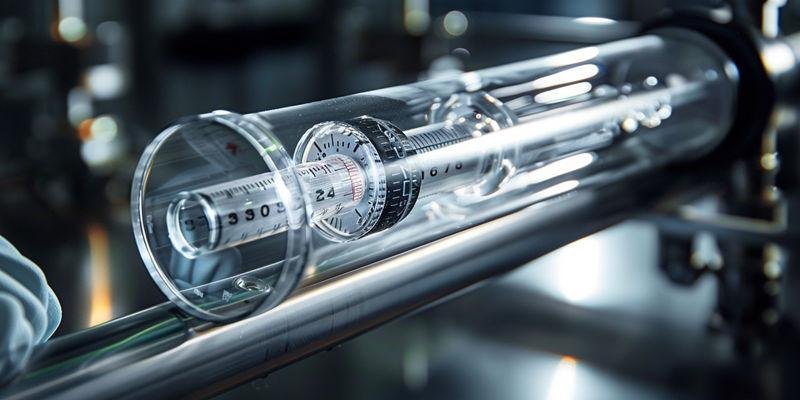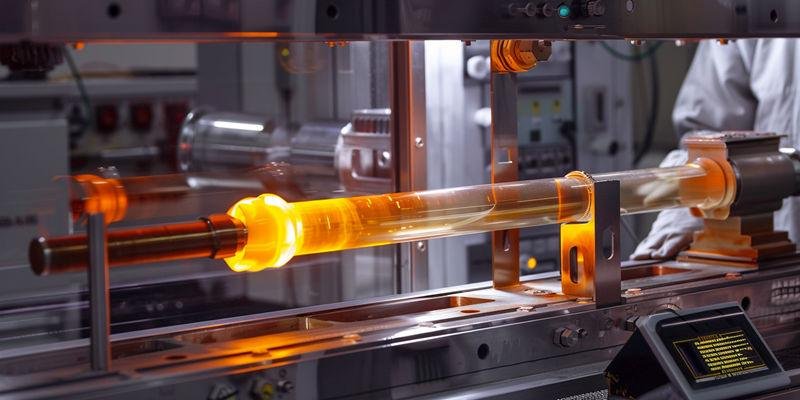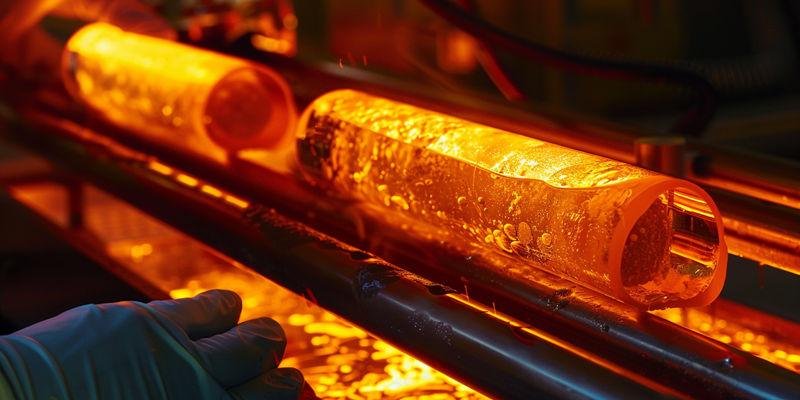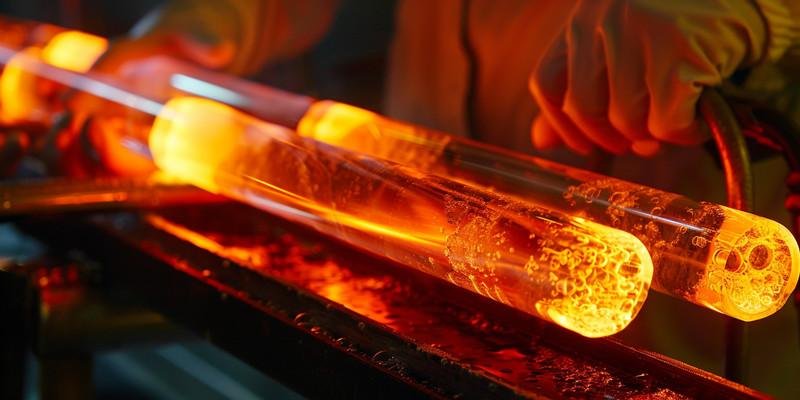Hochtemperaturanwendungen erfordern häufig Materialien, die extremen Bedingungen standhalten können. Wenn es um Quarzrohre geht, ist die Kenntnis ihrer Temperaturgrenze entscheidend für Ingenieure und Hersteller, die sich aufgrund ihrer Hochleistungsfähigkeit auf diese Materialien verlassen. Aber was genau definiert die Temperaturgrenze von Quarzrohren, und wie beeinflussen verschiedene Faktoren ihre Leistung?
Quarzröhren werden aufgrund ihrer hervorragenden Hitzebeständigkeit häufig in Hochtemperaturbereichen eingesetzt. Die Temperaturgrenzen dieser Röhren hängen von Faktoren wie Reinheit, Expositionsdauer und Umweltbedingungen ab.
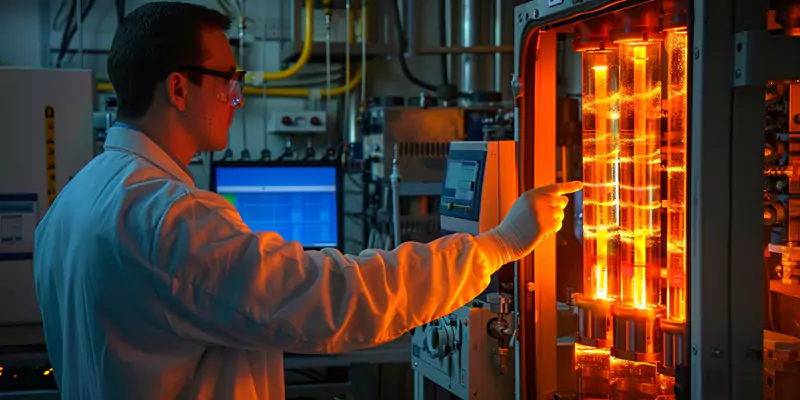
Wodurch wird die Temperaturgrenze von Quarzröhren bestimmt?
Die Temperaturgrenze von Quarzrohre hängt von verschiedenen Faktoren ab, darunter die Materialzusammensetzung und die Umgebungsbedingungen. Das Verständnis dieser Faktoren ist entscheidend für die Bestimmung der Höchsttemperatur, bei der Quarzrohre zuverlässig verwendet werden können. In diesem Abschnitt werden die wichtigsten Merkmale untersucht, die die Temperaturbeständigkeit von Quarzrohren bestimmen.
Die Grundlagen der thermischen Eigenschaften von Quarzglasrohren
Quarzglasrohre sind für ihre hervorragenden thermischen Eigenschaften bekannt, die in erster Linie auf den hohen Schmelzpunkt des Quarzglases zurückzuführen sind. Ihre Fähigkeit, thermischen Belastungen standzuhalten, ohne ihre strukturelle Integrität zu verlieren, macht sie ideal für Hochtemperaturanwendungen. Die geringe Wärmeausdehnung von Quarz sorgt außerdem dafür, dass es bei Temperaturschwankungen stabil bleibt.
Quarzglasrohre können ihre strukturelle Integrität auch bei hohen Temperaturen beibehalten, was sie zu einem bevorzugten Material in Umgebungen mit hoher Hitzeentwicklung macht. Ihre Leistung ist auf ihre einzigartige Wärmeleitfähigkeit zurückzuführen, die zu einem effizienten Wärmemanagement in verschiedenen Prozessen beiträgt. Dies macht Quarzrohre unverzichtbar für Industrien, die eine zuverlässige Hitzebeständigkeit benötigen.
Die hervorragenden thermischen Eigenschaften von Quarzglas sind in vielen industriellen Anwendungen, von der Fertigung bis zur wissenschaftlichen Forschung, von wesentlicher Bedeutung. Die hohe Temperaturtoleranz von Quarzrohren bedeutet, dass sie in Anwendungen, die mit anhaltender Hitze verbunden sind, effektiv arbeiten können. Daher ist ihr Einsatz in Branchen wie der Halbleiterherstellung, der chemischen Verarbeitung und der Laborforschung von entscheidender Bedeutung.
Wärmeleitfähigkeit und ihre Rolle bei der Temperaturbeständigkeit
Die Wärmeleitfähigkeit misst die Fähigkeit eines Materials, Wärme zu übertragen, und bei Quarzrohren spielt diese Eigenschaft eine Schlüsselrolle für ihre Temperaturbeständigkeit. Aufgrund ihrer geringen Wärmeleitfähigkeit können Quarzrohre eine konstante Innentemperatur beibehalten, selbst in Umgebungen mit hoher Hitze. Dies ist besonders wichtig bei Prozessen, bei denen die Temperaturkontrolle kritisch ist, wie z. B. bei der Herstellung von Halbleitern und bei chemischen Reaktionen.
Die niedrige Wärmeleitfähigkeit von Quarz bedeutet, dass es Wärme langsamer absorbiert, was dazu beiträgt, Überhitzung und Schäden bei Hochtemperaturoperationen zu vermeiden. Diese Eigenschaft ist von entscheidender Bedeutung, wenn die Rohre in Systemen eingesetzt werden, in denen eine präzise Temperaturregelung erforderlich ist, um die Unversehrtheit des zu verarbeitenden Materials zu gewährleisten.
Darüber hinaus ermöglicht die thermische Stabilität von Quarzrohren eine effiziente Funktion in Umgebungen mit schnellen Temperaturschwankungen. Ihre Fähigkeit, Temperaturschocks zu widerstehen, macht sie in anspruchsvollen industriellen Umgebungen äußerst langlebig und zuverlässig. Daher sind Quarzrohre das Material der Wahl in verschiedenen Hochtemperaturanwendungen, bei denen das Wärmemanagement von entscheidender Bedeutung ist.
Warum Quarzröhren für Hochtemperaturanwendungen gewählt werden
Quarzrohre werden aufgrund ihrer einzigartigen Kombination aus hoher Reinheit, hervorragender thermischer Stabilität und Beständigkeit gegen Temperaturschocks für Hochtemperaturanwendungen ausgewählt. Diese Eigenschaften sorgen dafür, dass Quarzrohre auch bei extremer Hitze stabil bleiben, was sie ideal für kritische industrielle Anwendungen macht.
Ihre Widerstandsfähigkeit gegen thermische Belastungen und die Fähigkeit, dauerhaft hohen Temperaturen standzuhalten, machen Quarzrohre zu einer zuverlässigen Option in verschiedenen Branchen. In Hochtemperaturumgebungen wie der Halbleiterfertigung können Quarzrohre ohne Beeinträchtigung funktionieren und gewährleisten ein hohes Leistungsniveau während ihrer gesamten Lebensdauer.
Darüber hinaus sind Quarzrohre sehr widerstandsfähig gegen chemische Korrosion, was ihre Verwendbarkeit in Hochtemperaturprozessen mit reaktiven Substanzen weiter erhöht. Diese Widerstandsfähigkeit in Verbindung mit ihrer Fähigkeit, bei Temperaturen von bis zu 1.200 °C zu arbeiten, macht Quarzrohre unverzichtbar für Industrien, die zuverlässige, langlebige Materialien benötigen.
Schlüsselfaktoren, die die Temperaturbeständigkeit von Quarzglasrohren beeinflussen
Die Temperaturbeständigkeit von Quarzrohren wird von mehreren Faktoren beeinflusst, darunter die Reinheit des Materials, die Expositionsdauer und die Umgebungsbedingungen. Das Verständnis dieser Faktoren ist wichtig, um die Eignung von Quarzrohren für verschiedene industrielle Anwendungen zu bestimmen. Dieser Abschnitt befasst sich mit den wichtigsten Faktoren, die die Temperaturgrenze von Quarzrohren bestimmen.
Reinheitsgrade und ihre Auswirkungen auf die Temperaturgrenzwerte
Der Reinheitsgrad von Quarz hat einen erheblichen Einfluss auf seine Temperaturbeständigkeit, wobei höhere Reinheitsgrade eine bessere Leistung bei höheren Temperaturen bieten. Hochreine Quarzrohre, in der Regel mit einem Reinheitsgrad von über 99,995% SiO₂, sind ideal für Hochtemperaturumgebungen, in denen es auf Präzision und Stabilität ankommt. Diese Rohre können Temperaturen von bis zu 1.200 °C standhalten und eignen sich daher für den Einsatz in Branchen wie der Halbleiterherstellung und optischen Anwendungen.
Der Reinheitsgrad von Quarzrohren beeinflusst nicht nur ihre Temperaturbeständigkeit, sondern auch ihre optische Klarheit und chemische Stabilität. Quarzrohre mit höherem Reinheitsgrad weisen weniger Verunreinigungen auf, was die Wahrscheinlichkeit chemischer Reaktionen bei hohen Temperaturen verringert. Dies macht sie zum Material der Wahl für Anwendungen, die sowohl Hitzebeständigkeit als auch chemische Inertheit erfordern.
Darüber hinaus bieten Quarzrohre mit höherem Reinheitsgrad eine gleichmäßigere Leistung über einen längeren Zeitraum, selbst bei extremer Hitze. Ihre langfristige Haltbarkeit sorgt dafür, dass sie in anspruchsvollen Umgebungen stabil und zuverlässig bleiben, was sie zu einem bevorzugten Material in Branchen macht, die Hochleistungskomponenten benötigen.
Dauer der Hitzeexposition: Langfristige vs. kurzfristige Exposition
Die Dauer, die Quarzrohre der Hitze ausgesetzt sind, wirkt sich auf ihre Temperaturbeständigkeit und ihre Gesamtlebensdauer aus. Kurzfristige Exposition gegenüber hohen Temperaturen verursacht möglicherweise keine nennenswerten Schäden, aber eine längere Exposition kann zu einer Verschlechterung und schließlich zum Ausfall führen. Daher ist es bei der Auswahl von Quarzrohren für bestimmte Anwendungen wichtig, den Unterschied zwischen Langzeit- und Kurzzeitbelastung zu kennen.
Bei kurzzeitigen Hochtemperaturanwendungen können Quarzrohre schnelle Aufheiz- und Abkühlzyklen ohne nennenswerte Auswirkungen auf ihre strukturelle Integrität überstehen. Bei Langzeitanwendungen kann die konstant hohe Hitze jedoch Verschleiß verursachen und möglicherweise zu Rissen oder anderen Schäden führen.
Die Kenntnis der Grenzen von Quarzrohren bei unterschiedlichen Expositionsdauern hilft Ingenieuren, fundierte Entscheidungen über ihre Verwendung in verschiedenen Branchen zu treffen. Es ist wichtig, die thermischen Belastungen zu berücksichtigen, die im Laufe der Zeit in Hochtemperaturumgebungen auftreten, um sicherzustellen, dass die Rohre während ihrer gesamten Betriebsdauer zuverlässig bleiben.
Umweltbedingungen: Der Einfluss von Atmosphäre und Druck auf die Grenzwerte
Die Umgebungsbedingungen spielen eine entscheidende Rolle bei der Bestimmung der Temperaturgrenze von Quarzrohren. Die Atmosphäre, in der die Rohre arbeiten, einschließlich des Vorhandenseins von Sauerstoff, Stickstoff oder anderen Gasen, kann ihre Leistung erheblich beeinflussen. So können Quarzrohre, die einem Vakuum oder inerten Gasen wie Stickstoff ausgesetzt sind, im Allgemeinen höheren Temperaturen standhalten als solche, die Sauerstoff oder reaktiven Chemikalien ausgesetzt sind.
Auch der Druck beeinflusst die Temperaturbeständigkeit von Quarzrohren. In Umgebungen mit höherem Druck können Quarzrohre zusätzlich belastet werden, was ihre Fähigkeit, extreme Temperaturen zu bewältigen, einschränken könnte. Das Verständnis des Zusammenspiels von atmosphärischem Druck, Temperatur und Gaszusammensetzung ist für die Auswahl von Quarzrohren, die bestimmten Umgebungsbedingungen standhalten können, von entscheidender Bedeutung.
In einigen Fällen kann die Fähigkeit von Quarzrohren, bei hohen Temperaturen zu funktionieren, durch die Verwendung kontrollierter Umgebungen verbessert werden. Durch die Optimierung von Faktoren wie Druck und Gaszusammensetzung können Quarzrohre ihr volles Potenzial an Temperaturbeständigkeit ausschöpfen, wodurch sie in anspruchsvollen Anwendungen zuverlässiger werden.
Wie Hochtemperatur-Quarzröhren getestet und bewertet werden
Die Prüfung und Bewertung von Hochtemperatur-Quarzrohren ist unerlässlich, um sicherzustellen, dass sie die erforderlichen Leistungsstandards für bestimmte Anwendungen erfüllen. Mithilfe standardisierter Methoden können Ingenieure ihre Haltbarkeit und Zuverlässigkeit in Hochtemperaturumgebungen beurteilen. Dieser Abschnitt befasst sich mit den Prüfverfahren, die zur Bewertung der Temperaturgrenzen von Quarzrohren eingesetzt werden.
Standardprüfverfahren für Quarzglasröhren
Quarzglasrohre werden einer Reihe von standardisierten Tests unterzogen, um ihre Widerstandsfähigkeit gegenüber hohen Temperaturen zu bewerten. Zu diesen Tests gehören Hitzebeständigkeitstests, thermische Zyklen und Belastungstests, die die Bedingungen simulieren, denen die Rohre im tatsächlichen Gebrauch ausgesetzt sind. Ingenieure nutzen diese Tests, um sicherzustellen, dass die Rohre die erforderlichen Spezifikationen für industrielle Anwendungen erfüllen.
Mit Hilfe von Standardprüfverfahren lassen sich die Temperaturgrenzen von Quarzrohren quantifizieren, indem man sie schrittweise steigenden Temperaturen aussetzt. Die Ergebnisse dieser Tests liefern wertvolle Daten darüber, wie sich Quarzrohre unter realen Bedingungen verhalten, und helfen den Herstellern, fundierte Entscheidungen über ihre Verwendung in bestimmten Prozessen zu treffen.
Indem Quarzrohre strengen Tests unterzogen werden, können Ingenieure sicherstellen, dass die Rohre den Temperaturen standhalten, denen sie während ihrer Nutzungsdauer ausgesetzt sind. Diese Tests helfen auch bei der Identifizierung potenzieller Fehlerstellen und gewährleisten die langfristige Zuverlässigkeit von Quarzrohren in Hochtemperaturumgebungen.
Reale Temperaturbelastungstests für Quarzröhren
Zusätzlich zu den Labortests werden reale Temperaturbelastungstests durchgeführt, um die Leistung von Quarzrohren unter tatsächlichen Betriebsbedingungen zu bewerten. Bei diesen Tests werden die Rohre schnellen Temperaturschwankungen und langfristiger starker Hitze ausgesetzt, um die Belastungen zu simulieren, denen sie in industriellen Anwendungen ausgesetzt sind.
Belastungstests sind unerlässlich, um festzustellen, wie Quarzrohre mit realen Herausforderungen wie Temperaturschocks, schneller Abkühlung und schwankenden Temperaturen umgehen. Diese Bedingungen sind in Branchen wie der Halbleiterherstellung üblich, wo Prozesse eine hochpräzise Temperaturkontrolle erfordern.
Durch die Prüfung von Quarzrohren unter realistischen Bedingungen können Ingenieure ihre Haltbarkeit und Zuverlässigkeit in Hochtemperaturanwendungen beurteilen. Dies hilft, Schwachstellen zu erkennen, die bei Standardtests möglicherweise nicht sichtbar sind, und stellt sicher, dass die Rohre beim Einsatz in realen Umgebungen wie erwartet funktionieren.
Wie Temperaturgrenzwerte in industriellen Anwendungen überprüft werden
Um die Temperaturgrenzen von Quarzrohren zu überprüfen, führen Ingenieure sowohl Labor- als auch Feldtests durch. Bei diesen Tests wird beurteilt, wie sich die Rohre unter realen industriellen Bedingungen verhalten, um sicherzustellen, dass sie die erforderlichen Spezifikationen für die Temperaturbeständigkeit erfüllen. Die Überprüfung der Temperaturgrenzen ist für die Gewährleistung der langfristigen Zuverlässigkeit von Quarzrohren in Hochtemperaturumgebungen unerlässlich.
Die Verifizierung umfasst sowohl simulierte als auch tatsächliche Betriebstests, bei denen die Röhren in kontrollierten und realen Umgebungen extremen Temperaturen ausgesetzt werden. Die Ingenieure überwachen die Leistung der Röhren, um potenzielle Fehlerstellen oder Anzeichen einer Verschlechterung im Laufe der Zeit zu erkennen.
Durch gründliche Verifizierungstests können die Hersteller sicherstellen, dass die Quarzrohre den Temperaturen standhalten, denen sie in den vorgesehenen Anwendungen ausgesetzt sind. Dieser Verifizierungsprozess garantiert, dass die Rohre in Hochtemperaturumgebungen, wie sie in der chemischen Verarbeitung oder der Halbleiterherstellung vorkommen, zuverlässig funktionieren.
Allgemeine industrielle Anwendungen von Hochtemperatur-Quarzröhren
Quarzglasrohre werden häufig in verschiedenen industriellen Anwendungen eingesetzt, bei denen hohe Temperaturen herrschen. Ihre Fähigkeit, extremer Hitze zu widerstehen, kombiniert mit ihrer Langlebigkeit und Beständigkeit gegen chemische Reaktionen, macht sie zu unverzichtbaren Komponenten in Branchen wie der Halbleiterherstellung, der chemischen Verarbeitung und der Laborprüfung.
Quarzröhren in der Halbleiterfertigung
Die Halbleiterherstellung umfasst hochpräzise Prozesse, die Materialien erfordern, die extremen Temperaturen standhalten. Quarzröhren werden in diesem Bereich für verschiedene Anwendungen eingesetzt, z. B. für die Reinigung von Wafern, Ätzen1und Ablagerung2. Ihre Fähigkeit, die strukturelle Integrität bei Temperaturen von bis zu 1.000°C zu bewahren, macht sie für diese Prozesse unverzichtbar.
Quarzröhren werden in der Halbleiterherstellung für Anwendungen verwendet, die eine präzise Temperaturkontrolle erfordern. Ihre Widerstandsfähigkeit gegen Temperaturschocks und ihre Fähigkeit, extremen Temperaturen standzuhalten, ohne sich zu verschlechtern, gewährleisten, dass sie die für hochpräzise Vorgänge erforderliche Leistung erbringen.
Außerdem werden Quarzrohre in Halbleitergeräten verwendet, die ein hohes Maß an Sauberkeit erfordern. Der geringe Verschmutzungsgrad von Quarz macht es ideal für den Einsatz in Umgebungen, in denen selbst kleinste Verunreinigungen die Qualität des Endprodukts beeinträchtigen können.
Quarzglasrohre in der Chemie- und Labortechnik
In der chemischen Verarbeitung werden Quarzrohre für Anwendungen wie die chemische Gasphasenabscheidung (CVD) und Hochtemperaturreaktoren verwendet. Ihre Widerstandsfähigkeit gegenüber chemischer Korrosion, ihre hohe thermische Stabilität und ihre Fähigkeit, extremer Hitze standzuhalten, machen sie in diesen Branchen unverzichtbar.
Quarzröhren werden in Laboratorien verwendet, in denen hohe Temperaturen für die Durchführung von Experimenten erforderlich sind. Ihre Fähigkeit, unter solchen Bedingungen zuverlässig zu arbeiten, ermöglicht es Forschern, genaue, wiederholbare Tests in kontrollierten Umgebungen durchzuführen.
Bei chemischen Reaktionen, die hohe Temperaturen erfordern, bieten Quarzrohre eine stabile und zuverlässige Plattform für die Durchführung von Prozessen wie Wärmebehandlung und chemische Synthese. Ihre Temperaturwechselbeständigkeit sorgt dafür, dass sie auch schnelle Temperaturschwankungen ohne Ausfall überstehen.
Andere wichtige Anwendungen in Hochtemperaturumgebungen
Quarzröhren werden auch in anderen kritischen Hochtemperaturanwendungen eingesetzt, z. B. in der Gasanalyse, bei Umwelttests und Sterilisationsprozessen. Ihre Fähigkeit, die strukturelle Integrität bei hohen Temperaturen zu erhalten, macht sie ideal für Branchen, die eine zuverlässige Leistung unter extremen Bedingungen benötigen.
In der Gasanalyse werden Quarzrohre zur präzisen Temperaturkontrolle während der Messungen eingesetzt. Ihre Fähigkeit, hohen Temperaturen standzuhalten, ohne sich zu zersetzen, gewährleistet, dass sie in einer Vielzahl von Analyseverfahren eingesetzt werden können.
Quarzglasrohre werden auch in Sterilisationsprozessen verwendet, wo sie aufgrund ihrer Hitze- und Chemikalienbeständigkeit die ideale Wahl sind, um eine wirksame und sichere Sterilisation von Materialien zu gewährleisten. Ihre Langlebigkeit und Temperaturwechselbeständigkeit machen sie für diese Anwendungen noch nützlicher.
Wie man die Lebensdauer von Quarzglasröhren bei hohen Temperaturen maximiert
Um die Lebensdauer von Quarzrohren in Hochtemperaturanwendungen zu maximieren, ist eine ordnungsgemäße Handhabung, Wartung und Temperaturkontrolle erforderlich. Durch die Einhaltung bewährter Verfahren können Ingenieure sicherstellen, dass die Rohre zuverlässig bleiben und während ihrer gesamten Betriebsdauer optimal funktionieren.
Wartungspraktiken zur Verlängerung der Lebensdauer von Quarzglasröhren
Regelmäßige Wartung ist der Schlüssel zur Verlängerung der Lebensdauer von Quarzrohren. Dazu gehört die Reinigung der Rohre, um alle Rückstände zu entfernen, die ihre Wärmeleitfähigkeit beeinträchtigen könnten, sowie die Überprüfung auf Anzeichen von Verschleiß oder Rissen, die ihre Leistung beeinträchtigen könnten.
Richtige Installation und Handhabung zur Vermeidung von Schäden
Die ordnungsgemäße Installation und Handhabung von Quarzglasrohren ist entscheidend für die Vermeidung von Schäden während des Gebrauchs. Die Vermeidung von plötzlichen Temperaturschwankungen und die sorgfältige Handhabung der Rohre während der Installation können ihre Langlebigkeit in Hochtemperaturumgebungen erheblich verbessern.
Wichtige Strategien zur Temperaturkontrolle für Quarzröhren
Um die Temperaturstabilität von Quarzrohren aufrechtzuerhalten, verwenden Ingenieure häufig Strategien zur Temperaturkontrolle wie Hitzeschilde, Isolierung und kontrollierte Heizraten. Diese Methoden tragen dazu bei, übermäßige Temperaturschocks zu vermeiden und sicherzustellen, dass die Rohre während der Verwendung innerhalb ihrer Temperaturgrenzen bleiben.
Vergleich von Hochtemperatur-Quarzglasrohren mit anderen Materialien
Quarzglas vs. Borosilikatglas: Welches Material hält sich besser?
Beim Vergleich zwischen Quarz und Borosilikatglas haben Quarzrohre bei Hochtemperaturanwendungen die Nase vorn. Borosilikatglas kann zwar mit mäßiger Hitze umgehen, ist aber bei extremer Hitze, insbesondere bei Temperaturen über 500 °C, nicht so leistungsfähig wie Quarz.
Warum Quarzröhren in Hochtemperaturumgebungen überlegen sind
Quarzglasrohre sind aufgrund ihrer geringen Wärmeausdehnung, ihrer hohen thermischen Stabilität und ihrer Beständigkeit gegenüber chemischer Korrosion bei hohen Temperaturen vielen anderen Materialien, einschließlich Borsilikat und bestimmten Metallen, bei Hochtemperaturanwendungen überlegen.
Leistungsunterschiede bei verschiedenen Hochtemperatur-Rohrmaterialien
Es gibt verschiedene Materialien für Hochtemperaturrohre, die jeweils ihre Stärken und Schwächen haben. Quarz bleibt jedoch die bevorzugte Wahl für Anwendungen, die höchste Temperaturbeständigkeit und Zuverlässigkeit erfordern.
Herausforderungen und Grenzen von Quarzglasröhren bei extremer Hitze
Wärmeschockbeständigkeit und Beschränkungen
Quarzrohre sind zwar sehr hitzebeständig, aber auch anfällig für Temperaturschocks. Schnelle Temperaturschwankungen können dazu führen, dass sie reißen oder brechen. Dies ist eine Einschränkung, die bei der Entwicklung von Prozessen mit hohen Temperaturzyklen berücksichtigt werden muss.
Umgang mit Riss- und Verformungsproblemen
Im Laufe der Zeit können Quarzrohre Risse bekommen oder sich verformen, wenn sie nicht ordnungsgemäß gewartet oder übermäßigen thermischen Belastungen ausgesetzt werden. Ingenieure müssen Systeme entwerfen, die solche Probleme verhindern, indem sie die Erwärmungs- und Abkühlungsraten während der Nutzung kontrollieren.
Wenn Quarzröhren in Hochtemperaturumgebungen nicht verwendet werden können
Es gibt Fälle, in denen Quarzrohre für Hochtemperaturanwendungen nicht geeignet sind, z. B. wenn sie bestimmten reaktiven Gasen oder extremen Temperaturen ausgesetzt sind, die ihre Toleranzgrenze überschreiten. In solchen Fällen können alternative Materialien erforderlich sein.
Schlussfolgerung
Die Kenntnis der Temperaturgrenzen von Quarzrohren ist für die Gewährleistung ihrer zuverlässigen Leistung bei Hochtemperaturanwendungen in verschiedenen Branchen von entscheidender Bedeutung. Durch die Berücksichtigung von Faktoren wie Reinheit, Expositionsdauer und Umweltbedingungen können Ingenieure die richtigen Quarzrohre für ihre Anforderungen auswählen.
Maximieren Sie die Leistung Ihrer Quarzrohre mit den hochreinen Quarzrohren von TOQUARTZ, die direkt ab Werk geliefert werden. Nutzen Sie unsere über 20-jährige Erfahrung, um die perfekte Lösung für Ihre Hochtemperaturanwendungen zu finden.
FAQ (Häufig gestellte Fragen)
Wie hoch ist die maximale Temperatur, die Quarzrohre aushalten können?
Quarzröhren können je nach ihrer Reinheit und den Expositionsbedingungen Temperaturen von bis zu 1.200 °C im Dauereinsatz standhalten.Wie kann ich die Lebensdauer meiner Quarzrohre in Hochtemperaturanwendungen verlängern?
Die richtige Handhabung, die Installation von Hitzeschilden und die Einhaltung der empfohlenen Temperaturkontrollstrategien können dazu beitragen, die Lebensdauer von Quarzrohren zu verlängern.Was sollte ich bei der Auswahl von Quarzrohren für Halbleiteranwendungen beachten?
Für Halbleiteranwendungen ist es wichtig, hochreine Quarzrohre zu wählen, um die erforderliche Temperaturbeständigkeit zu gewährleisten und Verunreinigungen zu vermeiden.Wie schneiden Quarzglasrohre im Vergleich zu Borosilikatglas bei Hochtemperaturanwendungen ab?
Quarzglasrohre übertreffen Borosilikatglas in Hochtemperaturbereichen aufgrund ihrer überlegenen thermischen Stabilität und Temperaturwechselbeständigkeit.
Referenzen:
Die Erforschung von Ätztechniken kann Ihr Wissen über die Halbleiterherstellung erweitern und die Prozesseffizienz verbessern.↩
Erfahren Sie, wie Quarzrohre eine entscheidende Rolle bei Abscheidungsprozessen spielen, die für die Herstellung dünner Schichten in der Halbleiterfertigung unerlässlich sind.↩


